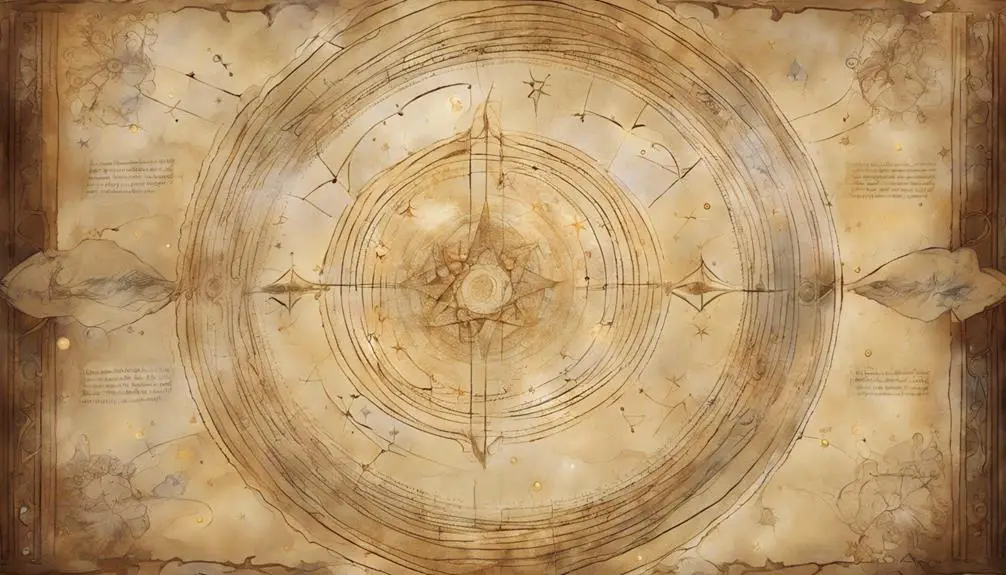Explore the enigmatic world of 'Wandering Stars in the Bible' and uncover celestial secrets intertwined with ancient wisdom.

Wandering Stars in the Bible
Isn't it intriguing that on a clear night, you might gaze up at the stars, unaware that the Bible mentions these very celestial wanderers?
You've likely heard references to 'wandering stars' without realizing their complex tapestry of meanings, both astronomical and symbolic, threading through the ancient texts.
The term, rich in metaphorical layers, prompts a deeper exploration into its origins, biblical citations, and the moral and theological implications that have captivated scholars and the faithful alike.
So, let's embark on this journey together, uncovering the mysteries that these celestial beings might reveal about the universe and our place within it.
Key Takeaways
- 'Wandering stars' in biblical texts often symbolize moral or spiritual guidance, misguidance, or divine judgment.
- The term reflects ancient understanding of planets, highlighting their unique movements against the backdrop of fixed stars.
- Translation and interpretation challenges of biblical references to 'wandering stars' underscore the importance of context and cultural nuances.
- Symbolism associated with 'wandering stars' offers profound insights into theological concepts and ancient perceptions of the cosmos.
Origins of the Term

The term 'wandering stars' in biblical contexts originates from ancient observations of celestial bodies that moved differently from the fixed stars in the night sky. You'll find that linguistic evolution plays a significant role in how these observations were interpreted and integrated into religious texts. Over time, the language used to describe these phenomena has transformed, influenced by cultural and scientific understandings.
In the ancient world, the concept of a 'wandering star' wasn't just a literal description but also carried symbolic weight. Cultural influences shaped the narratives surrounding these celestial bodies, attributing them with divine or ominous significance. As societies evolved, so did their cosmologies, and the terminology used in sacred texts reflected these shifts in understanding.
You're witnessing a fascinating intersection of language, culture, and science in the biblical term 'wandering stars.' This term's evolution reflects broader changes in human thought and the gradual incorporation of empirical observation into spiritual and philosophical frameworks. The way ancient peoples conceptualized the heavens tells you much about their worldview, and the linguistic legacy of terms like 'wandering stars' offers insights into the interface between human culture and the cosmos.
Astronomical Context

Exploring the astronomical context, you'll uncover that what ancient texts refer to as wandering stars are actually planets, distinct from the fixed stars due to their unique orbital paths around the sun. This revelation not only illuminates the historical inaccuracies in early interpretations but also underscores the profound impact of cultural influences on the understanding of celestial phenomena. Ancient observers, lacking the sophisticated tools and knowledge we possess today, relied heavily on their naked-eye observations. Their interpretations, deeply intertwined with their cultural and religious beliefs, often led to misclassifications of astronomical objects.
This historical context is crucial for comprehending how these celestial bodies were perceived and why they were categorized in such a manner. It highlights the evolution of astronomical knowledge and how cultural perspectives can shape, and sometimes distort, our understanding of the universe. The term 'wandering stars', therefore, serves as a fascinating example of how early astronomical observations were influenced by the technological limitations and cultural contexts of the time. Through this lens, you gain a deeper appreciation for the journey from ancient astronomy to the modern understanding of planets and their motions.
Biblical Citations

Delving into biblical texts reveals that references to 'wandering stars' are metaphorically rich, offering insights into ancient cosmological understandings and their theological implications. These citations, embedded in the fabric of scriptural narratives, pose unique translation challenges and mirror the cultural perceptions of the era.
To navigate these complexities, consider the following:
- Translation challenges: The term 'wandering stars' undergoes nuanced interpretations across different Bible versions, reflecting the evolving understanding of astronomy and the intricacies of language translation.
- Cultural perceptions: These references encapsulate the worldview of ancient societies, where celestial bodies were often imbued with divine or ominous significance, influencing how events on Earth were interpreted.
- Scriptural contexts: Each mention of 'wandering stars' is contextually specific, rooted in the narrative or prophetic message, thereby requiring a careful analysis of the surrounding text to grasp its full meaning.
- Theological implications: Beyond the literal celestial phenomena, 'wandering stars' symbolize deeper spiritual truths or warnings, demonstrating the interplay between observable nature and spiritual lessons.
Understanding these aspects enriches one's appreciation of the biblical text, bridging the gap between ancient and modern readers through a shared sky observed across millennia.
Symbolic Interpretations

In biblical literature, 'wandering stars' serve as potent symbols, reflecting multifaceted theological and moral lessons shaped by ancient cosmological understandings. These celestial metaphors illuminate the texts, offering you insights into the mindset of ancient societies. They didn't just see the sky; they read it, interpreting the movements of stars and planets as divine messages. This reading often led to historical inaccuracies, as their understanding was based on observation without modern scientific tools. Yet, these inaccuracies don't detract from the symbolic power wielded by these celestial bodies in the biblical narrative.
You'll find that 'wandering stars' often symbolize transience, misguidance, or divine wrath, underscoring the precarious nature of human existence against the backdrop of an immutable cosmic order. This symbolism isn't accidental but deeply embedded in the cultural and theological fabric of the time. The ancients' engagement with the cosmos through these metaphors reveals a profound attempt to decode the divine will, suggesting that the heavens were a vast, divine text to be interpreted by those wise enough to understand its signs. This approach provides a rich, contextual backdrop against which the biblical messages were crafted and understood.
Moral and Theological Implications

Through the lens of 'wandering stars' in biblical texts, we uncover profound moral and theological implications that challenge and guide human conduct in relation to the divine. These celestial phenomena serve not merely as physical entities but as symbols carrying deep spiritual lessons. Here are some key insights:
- Divine Punishment: The imagery of wandering stars has been associated with divine punishment for disobedience. It's a stark reminder that actions contrary to divine will can lead to spiritual wandering, akin to the aimless paths of these stars.
- Human Navigation: Just as ancient mariners used stars for navigation, these biblical references can be seen as guiding lights for moral and spiritual direction, urging individuals to align their life's journey with divine principles.
- Temporal vs. Eternal: The wandering stars contrast with the fixed stars to symbolize the transient versus the eternal. It encourages a focus on eternal values over fleeting worldly desires.
- Warning Against Spiritual Deception: These stars also serve as a warning against being led astray by false teachings or prophets, emphasizing the importance of discernment in spiritual matters.
Frequently Asked Questions
How Have Different Cultures Apart From the Biblical Context Interpreted or Named Wandering Stars, and What Significance Did They Hold?
Throughout history, cultures have given unique names and meanings to wandering stars, often viewed as celestial beings or omens. In Greek mythology, they were personified as gods, influencing human fate.
Astrological interpretations across cultures have ascribed these stars roles in predicting events and shaping personalities. You'll find that these interpretations, rich in symbolism and belief, underscore humanity's enduring fascination with the cosmos, beyond any single religious or cultural narrative.
Are There Any Specific Rituals or Traditions in Judaism or Christianity That Are Directly Associated With or Inspired by Wandering Stars?
You won't find specific rituals or traditions within Judaism or Christianity that directly tie to wandering stars, like star naming ceremonies or planetary prayers. These practices don't traditionally align with the rituals and beliefs of these faiths.
Instead, their spiritual practices and observances focus more on the interpretation of texts and the observance of commandments rather than celestial phenomena. So, the connection between wandering stars and these religions is more interpretive than ritualistic.
How Do Contemporary Astronomers View the Concept of Wandering Stars in Relation to the Bible's Depiction, and Do They Find Any Scientific Inaccuracies?
You're exploring how astronomers view wandering stars, stepping away from biblical references. They focus on planetary alignment and star classification, analyzing movements and categorizing stars based on their characteristics.
You'd find that astronomers generally regard the biblical depiction of wandering stars as metaphorical, not scientifically accurate. They emphasize the importance of empirical evidence and advanced technology in understanding celestial bodies, which often reveals discrepancies with ancient texts.
Can Wandering Stars in the Bible Be Linked to Any Specific Historical or Astronomical Events, Such as Comets or Supernovae, That Occurred During Biblical Times?
You're exploring if ancient observations, tagged as wandering stars, tie to real astronomical phenomena like comets or supernovae from that era. Scholars delve into this by examining records of planetary alignments or Zodiac interpretations from those times. They analyze texts and artifacts to identify any connections.
This approach helps in understanding how people back then interpreted celestial events, offering insights into their knowledge and how it influenced their cultural and religious beliefs.
How Have Depictions of Wandering Stars in the Bible Influenced Art, Literature, or Music Throughout History?
You'll find that star symbolism, rooted in ancient texts, has profoundly influenced art, literature, and music over centuries.
Modern interpretations often draw on these enigmatic symbols, weaving them into narratives and compositions that reflect humanity's enduring fascination with the cosmos.
This rich tradition showcases how celestial imagery, including the concept of wandering stars, has been a source of inspiration, offering a bridge between the mystical past and contemporary creative expression.
Conclusion
In conclusion, you've explored the origins, astronomical context, and biblical citations of 'wandering stars,' alongside their symbolic interpretations and moral implications.
This examination reveals their significance not just in celestial mechanics but in the broader theological discourse.
By understanding these stars' roles in ancient texts, you grasp the complex interplay between the heavens and moral teachings, highlighting the profound ways in which cosmic phenomena are woven into the fabric of spiritual and ethical understanding.



Sign up